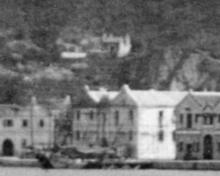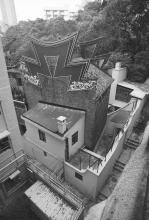Built in 1884, according to the HKTB:
There is a deity for just about everything in the spiritual melting pot of Hong Kong. Located in Kennedy Town on the western end of Hong Kong Island, the Lo Pan Temple is the only temple in Hong Kong dedicated to Lo Pan, the patron saint of Chinese builders and carpenters. Lo Pan (also known as Lu Ban) was a Chinese carpenter, engineer, philosopher, inventor, military thinker and statesman who lived during the Spring and Autumn Period (771–476 BC).
Carvings inside the temple reveal it was constructed in 1884 by the Contractors’ Guild through donations from people of related trades. Nowadays, most worshippers are building workers who wish to pay homage to their industry sage and pray for his blessing. These devotees celebrate the birthday of Lo Pan on the 13th day of the sixth Chinese lunar month each year.
The temple is a two-hall structure richly decorated with mural paintings, as well as Shiwan ceramic figurines and mouldings. On the two sides of the main door are engravings of Chinese poems that praise Lo Pan’s contribution to architecture. Restoration on this Grade 1 historical building involved work on the roof’s tiles, purlins (roof beams) and walls.


Comments
I always find the characters
I always find the characters on this roof are very detailed. Here's a view of the roof looking from To Li Terrace, which is above the temple.
And here's a close-up of the centre section.
Lo Pan Temple
Dear All,
I am an architect and doing an research on Lo Pan Temple in Kennedy Town. However, I hardly find any relevant old photos especially panorama/ aerial pictures of the district and its immediate context (e.g. Ching Lin Terrace). Does anyone know more about this area in the early 20th century (e.g. around 1900 to 1930 when the temple was revamped in 1928) and may recommend some other sources for my further research (especially visual resources) ?
Regards, Bill